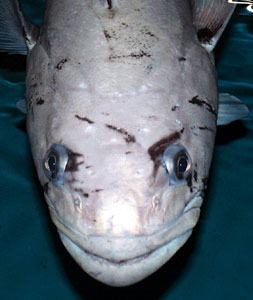






 |
 |

Antarctic Toothfish (Pagothenia borchgrevinki)
Caption:
An Antarctic toothfish (Pagothenia borchgrevinki). This image was taken as part of the on-going NSF-supported "seal cam" research project in which scientists use seals as "eyes" to see what goes on underneath the Antarctic ice (see "More about this Image," below). The Antarctic Weddell seals are a predator of the toothfish.
The toothfish is found throughout Antarctica and the Antarctic Peninsula, South Orkney Islands, and South Shetland Islands from 0 to 695 meters depth. Toothfish is a commonly seen fish associated with the sea ice along the Antarctic shore and has been observed clinging to the underside of thick ice shelves. The toothfish can grow up to 28 centimeters in length. A well-adapted hunter, toothfish's lateral line sensory system can detect prey by recognizing the low vibration frequencies emitted by swimming crustaceans. Toothfish eat free-swimming shelled pteropod mollusk, ice krill, copepods, decapod crustacean larvae, chaetognaths, amphipods, and juvenile fish. [See related images: Toothfish Under the Antarctic Ice, A Playful Display Under the Antarctic Ice, Weddell Seal Pup, Weddell Seal Resting on Ice, Weddell Seal Displays Catch, and Weddell Seal Wearing "Seal Cam."]
Important: Use of this image is restricted. Please see “Restrictions” (below) for complete information.
More about this Image
Researchers Lee Fuiman from the University of Texas at Austin, Randall Davis from Texas A&M; University, Galveston, and Terrie Williams from the University of California, Santa Cruz equipped 15 Antarctic Weddell seals with video cameras, infrared LEDs, and data recorders. As a result, they've gained new insights into the habits of two very important Southern Ocean fish species—the Antarctic silverfish (Pleurogramma antarcticum) and the Antarctic toothfish (Pagothenia borchgrevinki). The seals—marine predators—serve as guided, high speed, midwater sampling devices for fish that have been especially difficult to study. New information about the behavior and distribution of these species indicates that some existing theories may need to be revised. Although “seal cam” has its limitations, it is a promising technique and could be used to study other pelagic and deepwater fishes and invertebrates that are otherwise impossible to observe in their natural environment.
This work was supported by NSF Office of Polar Programs (OPP) grants OPP 96-14857, OPP 97-08151, and OPP 96-18384, and by the West Coast Office of the National Undersea Research Program, grant UAF 02-0080.

(Preview Only)

|
| Credit: |
Credit Randall Davis, Texas A&M; University; images under authorization of Marine Mammal Permit No. 821-1588-01. |
| Year of Image: |
2001 |
|
Categories:
POLAR SCIENCE / Antarctic
ANIMALS / BIRDS / REPTILES / FISH
Formats Available:
TIFF Format - 1.38M - 758 x 638 pixel image - 72 DPI
Sorry! This image is not available in a higher resolution format.
Restrictions:
Important: Permission has been granted to use this image for personal and educational purposes only. Any other use of this image is prohibited without the express permission of Dr. Randall Davis, Texas A&M; University. Contact Davis via e-mail at davisr@tamug.tamu.edu.
|